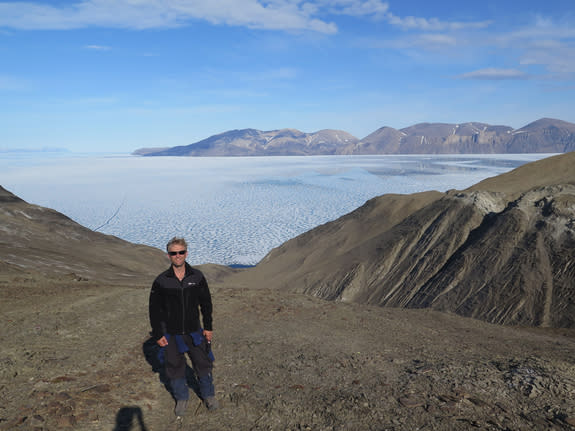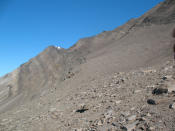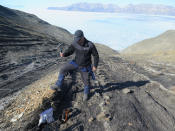A Prehistoric Murder Mystery: Earth's Worst Mass Extinctions
Paul Wignall is the author of "The Worst of Times: How Life on Earth Survived Eighty Million Years of Extinctions" (Princeton University Press). He is professor of paleoenvironments at the University of Leeds. He has been investigating mass extinctions for more than 25 years, a scientific quest that has taken him to dozens of countries around the world. Wignall contributed this article to Live Science's Expert Voices: Op-Ed & Insights.
There have been good times and bad times in world history, but none so bad as a catastrophic 80 million years of history that wiped out nearly every species on the planet.
Beginning 260 million years ago, this phase included the worst mass extinction in Earth's history at the end of the Permian period, another mass extinction at the end of the Triassic period and several more major crises. Those calamities totally changed the composition of life on Earth. The crises of this worst-ever 80 million years all share many features in common, especially intense global warming and remarkable changes in the ocean that led to widespread stagnation. These changes went hand-in-hand with devastating extinction losses. But what is even more extraordinary is that nothing that terrible has happened ever since, with the single, glaring exception of a giant meteorite impact 65 million years ago that is said to have wiped out the nonavian dinosaurs. What was so at this time, and why has it been (mostly) plain sailing ever since?
A deadly time
Geologists attempting to understand the cause of mass extinctions are faced with a giant murder mystery. Fortunately, all the extinctions of the 80-million-year span have a giant smoking gun, because they all coincided with the eruptions of vast lava fields. The link is perfect, even if not perfectly understood. The end-Permian mass extinction 252 million years ago coincided with basalt eruptions in Siberia, and the end-Triassic mass extinction coincided with volcanism as the American and North African continents fused together.
The scale of outpouring lava was vast — much greater than anything we see today — with individual flows hundreds of feet thick and covering thousands of square miles. Their remains form the impressive landscapes of places today, like the Giant's Causeway in Northern Ireland, and the Columbia River Gorge in the American Pacific Northwest. These lava flows would have caused regional devastation, but it is the gasses that came out at the same time that seem to have caused trouble for the planet as a whole. These gas emissions consisted of carbon dioxide, sulfur dioxide, nasty halogens and potentially a lot of other noxious gasses caused by the magma baking crustal rocks. Those gasses are capable of generating a range of adverse effects, including global warming, acid rain, ozone destruction and ocean acidification.
But where are the extinctions?
If vast volcanism can cause giant problems, then it is a no-brainer that mass extinction will follow. But here is the rub: Since the early Jurassic, around 180 million years ago, there have been many more huge eruptions spewing out vast fields of flood basalt, but none have caused any extinctions like those that came before.
For example, one of the largest lava fields ever to erupt on Earth was formed in the North Atlantic region 60 million years ago. This was around the end of the Paleocene period, but there was no end-Paleocene mass extinction. Why not?
Many geologists, including myself, have been trying to get to the bottom of this mystery over the past few years. Doing so requires both an understanding of how mass extinctions were caused and what climate changes were like during the later, more benign, eruptions.
Scientific findings suggest that the arrangement of the continents was an important element. The Permian eruptions occurred at a time when nearly all the world's continental masses were united into a single expanse called Pangaea. The result was a world that appears to have been singularly incapable of coping with sudden volcanic gas emissions into the atmosphere.
All environments were affected, from plankton in the oceans to forests on land. Coral reefs were repeatedly wiped out, and land animals — dominated by primitive reptiles and amphibians — lost huge numbers of species. [Here's More Proof Earth Is in Its 6th Mass Extinction ]
By the time it was all over, around 180 million years ago, dinosaurs were on their way to rule the land, and modern mollusks, such as clams and gastropods were the dominant shellfish of the seas. The dinosaurs were lucky to live at a time of supercontinent breakup; Pangea was fragmenting into the familiar multicontinent world of today. Flood basalt eruptions were part of this process, generally occurring at the time of initial rifting, but they were not triggering any more mass extinctions. Some of these later eruptions did have the hallmarks of the earlier extinctions, namely global warming and ocean stagnation, but these phenomena never seem to have been as intense and prolonged as the earlier times. Only the Deccan Traps eruptions in India can be clearly tied in to an extinction, but it is a long-debated point that the coincident impact of a giant meteorite did all the damage at this time. It is noteworthy that this dinosaur extinction event was very different to the extinctions of Pangea and its extreme abruptness seems, to most geologists, to best implicate the impact as the main cause.
The secrets in the rocks
Understanding the poor health of the world's species before the dinosaurs requires studying widely dispersed rocks, many of them now found in mountain ranges (such as the Himalayas or in central Japan) where there are sedimentary rocks that used to be at the bottom of a deep ocean.
The layers of rocks contain clues to exceptionally harsh conditions that included oxygen-deprived oceans and baking-hot seas. Many of those changes occurred very quickly, as if a tipping point had been rapidly crossed. It seems that the world of Pangaea was often pushed beyond the brink of disaster.
The reasons for this have to do with the way volcanic gasses are removed from the atmosphere. Nowadays, many gasses are rapidly taken out of the atmosphere and end up in the oceans, where, ultimately, they are incorporated into sediments at the bottom. This natural cycling seems to slow down when there is a supercontinent present, with catastrophic consequences for life. In particular, the release of volcanic gasses starts to have a cumulative effect. So, as each eruption occurs the climate-changing gasses of earlier eruptions are still wreaking their changes, and the later eruptions just exacerbate these effects. The end-result was runaway greenhouse climates and oceans that were lethal for life.
Somewhat paradoxically, understanding the workings of this ancient world also provides a perspective into how our own world works. It is unlikely that we will ever witness a scale of volcanism akin to the giant flood basalts of the past, at least not in the next few thousand years — but the pollution in the atmosphere from the burning of fossil fuels is replicating atmospheric change on a similar scale.
Thankfully, the planet's workings seem much more resilient to these changes, offering the hope that we will not be stepping back to the world's worst times.
More on Wignall's book is available from the book's Princeton University Press site.
Follow all of the Expert Voices issues and debates — and become part of the discussion — on Facebook, Twitter and Google+. The views expressed are those of the author and do not necessarily reflect the views of the publisher. This version of the article was originally published on Live Science.
Copyright 2015 LiveScience, a Purch company. All rights reserved. This material may not be published, broadcast, rewritten or redistributed.











